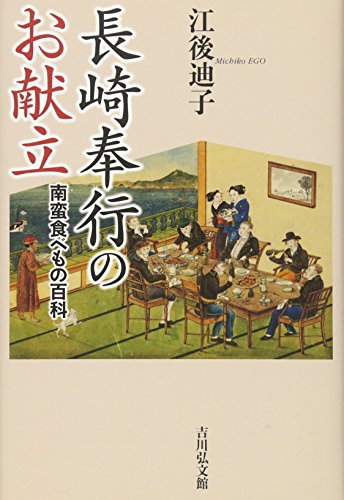16 0 0 0 OA 江戸時代の料理名にみる“なんばん”,“おらんだ”について
- 著者
- 橋爪 伸子 江後 迪子
- 出版者
- 一般社団法人 日本調理科学会
- 雑誌
- 日本調理科学会誌 (ISSN:13411535)
- 巻号頁・発行日
- vol.30, no.4, pp.355-363, 1997-11-20 (Released:2013-04-26)
- 参考文献数
- 19
The food culture of Japan has been influenced by Nanban Trade that started at the late Muromachi era. Many Japanese dishes today bear the word Nanban, Oranda, etc. in their names. In this paper I have investigated the characteristic of the dishes with the naming Nabban and Oranda in the cooking books published in the Edo era.The common food materials to these dishes were eggs, sea breams, oil, chilipepper and Japanese leeks. In addition, meat and fat were specifically used for dishes naming Nanban and chilipepper, Japanese leeks and oil were combined to use was for Oranda. Nanban dishes appeared in the late Muromachi era and through the Edo era. Oranda dishes increased their numbers from 1800 downward.
8 0 0 0 OA ラーメンの世代別,地域別嗜好 : 福岡,長崎,大分,熊本,鹿児島,東京の場合
- 著者
- 近 雅代 沼田 貴美子 江後 迪子 左 篤子 外西 壽鶴子
- 出版者
- 福岡国際大学・福岡女子短期大学
- 雑誌
- 福岡女子短大紀要 (ISSN:02860546)
- 巻号頁・発行日
- vol.61, pp.25-39, 2003-02-28
福岡県太宰府市,長崎市,大分市,熊本市,鹿児島市と東京都文京区で1816人を対象に小学生,学生,成人の三つの世代に分けてラーメンがどのように食べられているか調べた。1.ラーメンが「好き」な人は「大好き」な人も含めて小学生,学生の世代で85%,成人の世代で68%に達した。全体として79%の人がラーメンを好み,世代を超えて好まれていることが分かった。ラーメンが「大好き」な人は小学生に多く,年齢が若い世代の人により好まれているようである。2.長崎の成人においてラーメンの「大好き」と「好き」が少なかったのは,チャンポンや皿うどんなどの食文化が,長崎ではラーメンより古くからあったためと考えられる。3.どの世代もどの地域でもラーメンは間食ではなく1回の食事として位置づけていた。4.澄んだスープは東京の人が,濁ったスープは九州の人が世代を問わず好んでいた。世代別で見ると「学生」の世代が濁ったスープを好む割合が高かった。5.世代を問わずとんこつ味が好まれていた。地域別では,しょうゆ味を東京が,とんこつ味を九州地域が好んでいた。6.ラーメンの好まれる具材は世代によって異なった。「小学生」は,焼き豚,コーン,ねぎ,たまご,もやしを,「学生」は焼き豚,ねぎ,もやし,コーン,たまごを,「成人」はねぎ,もやし,焼き豚,メンマ,キャベツを,この順に好んでいた。地域の特徴は,福岡のごま,鹿児島と大分のキャベツ,東京と長崎のメンマ,熊本のきくらげにみられた。7.ラーメン店は九州では,古くから鹿児島において人口に対して多く存在していた。
1 0 0 0 長崎奉行のお献立 : 南蛮食べもの百科
- 著者
- 江後 迪子 Ego Michiko
- 出版者
- 独立行政法人国立文化財機構奈良文化財研究所文化遺産部遺跡整備研究室
- 巻号頁・発行日
- pp.35-42, 2021-03-31
本報告書は、令和2年(2020)10月16日(金)に奈良文化財研究所大会議室において開催した令和2年度奈良文化財研究所遺跡整備・活用研究集会"歴史的脈絡に因む遺跡の活用 ―儀式・行事の再現と地域間交流の再構築― "に関する報告書である。
1 0 0 0 古典料理について-島津家の婚礼規式と饗膳-
- 著者
- 高正 晴子 江後 迪子
- 出版者
- 一般社団法人 日本家政学会
- 雑誌
- 日本家政学会誌 = Journal of home economics of Japan (ISSN:09135227)
- 巻号頁・発行日
- vol.50, no.8, pp.835-844, 1999-08
- 参考文献数
- 48
- 被引用文献数
- 1
The characteristics and types of food served at wedding ceremonies of the Shimazu household in Kyushu are described.<BR>Shimazu wedding ceremonies were different from those of other major households. Food was served after exchanging <I>sake</I> cups. <I>Zoni</I> (a kind of mochi soup) and five kinds of <I>kezurimono</I> were included on the wedding menu. <I>Jinchu</I> (five-color rice), and <I>tegake</I> (a kind of <I>kezurimono</I>) and <I>tokokazari</I> (an alcove ornament) cannot be found at the wedding ceremonies of other important feudal lords. Thus, the Shimazu ceremonies were clearly different, although they were simplified over the years.
1 0 0 0 OA 古典料理について
- 著者
- 高正 晴子 江後 迪子
- 出版者
- The Japan Society of Home Economics
- 雑誌
- 日本家政学会誌 (ISSN:09135227)
- 巻号頁・発行日
- vol.50, no.8, pp.835-844, 1999-08-15 (Released:2010-03-10)
- 参考文献数
- 48
The characteristics and types of food served at wedding ceremonies of the Shimazu household in Kyushu are described.Shimazu wedding ceremonies were different from those of other major households. Food was served after exchanging sake cups. Zoni (a kind of mochi soup) and five kinds of kezurimono were included on the wedding menu. Jinchu (five-color rice), and tegake (a kind of kezurimono) and tokokazari (an alcove ornament) cannot be found at the wedding ceremonies of other important feudal lords. Thus, the Shimazu ceremonies were clearly different, although they were simplified over the years.
1 0 0 0 16世紀から17世紀における菓子について
- 著者
- 江後 迪子 山下 光雄
- 出版者
- The Japan Society of Cookery Science
- 雑誌
- 日本調理科学会誌 (ISSN:13411535)
- 巻号頁・発行日
- vol.30, no.2, pp.106-113, 1997
The Japanese sweets which appeared intherecord of the 16th and 17th century were studied by employing the literature “Onari” and “Chakai” from the 16th to the 17th and “The Menu of Chosentsusinsi”. The introduction of the processed sweets and the historical changes of the sweets were investigated.<br>The result showed that nuts and fruits were popular in the 16th century, while the processed sweets and Nanban sweets were increased in quantity and variety. It was greatly influenced by the entertainment of Chosentsusinsi.
1 0 0 0 野菜の生食調理におけるビタミンC含量の変化
- 著者
- 伊達 郁子 江後 迪子
- 出版者
- 一般社団法人 日本家政学会
- 雑誌
- 家政学雑誌 (ISSN:04499069)
- 巻号頁・発行日
- vol.35, no.8, pp.569-572, 1984
1) 野菜を切断後水浸することによりV.Cの損失が認められ, 組織の破壊度が大きいほど, 損失も大きかった.<BR>2) 野菜を切断後水浸することによって失われるTAA量は水浸10分間でそのほとんどが溶出した.<BR>3) だいこんを切断処理後室温に放置した場合は, 水浸したときに比べて残存率が高く, 放置した場合の空気による酸化よりも水溶液中への溶出が大きいことが認められた.<BR>4) 銅製おろし金と磁製おろし器の両者を用いて調製した, だいこんおろしのTAA量はほぼ同一であり, 今回用いた銅器具によるV.Cの損失はなかった.
1 0 0 0 OA 16世紀から17世紀における菓子について
- 著者
- 江後 迪子 山下 光雄
- 出版者
- 一般社団法人 日本調理科学会
- 雑誌
- 日本調理科学会誌 (ISSN:13411535)
- 巻号頁・発行日
- vol.30, no.2, pp.106-113, 1997-05-20 (Released:2013-04-26)
- 参考文献数
- 35
The Japanese sweets which appeared intherecord of the 16th and 17th century were studied by employing the literature “Onari” and “Chakai” from the 16th to the 17th and “The Menu of Chosentsusinsi”. The introduction of the processed sweets and the historical changes of the sweets were investigated.The result showed that nuts and fruits were popular in the 16th century, while the processed sweets and Nanban sweets were increased in quantity and variety. It was greatly influenced by the entertainment of Chosentsusinsi.

